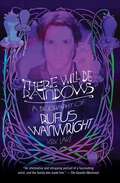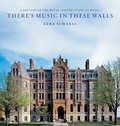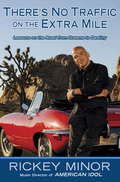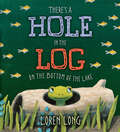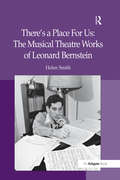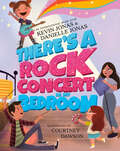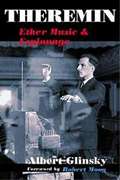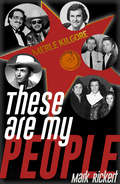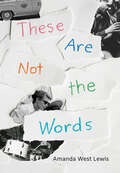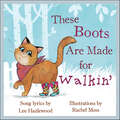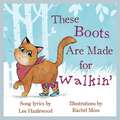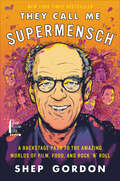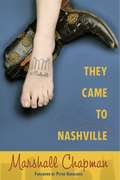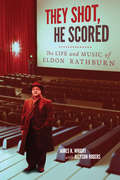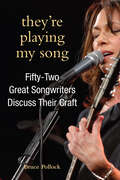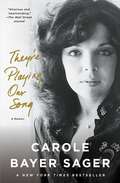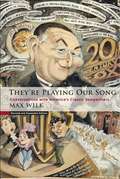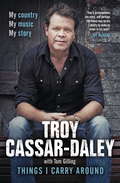- Table View
- List View
There Was an Old Lady Who Swallowed a Fly
by Simms TabackThere was an old lady who swallowed a fly, a favorite American folk poem, was first heard in the United States in the 1940's. Using an ever-expanding die-cut hole, Simms Taback gives us a rollicking, eye-popping version of the well-loved poem.
There Will Be Rainbows: A Biography of Rufus Wainwright
by Kirk LakeThe first biography of legendary singer/songwriter/composer Rufus Wainwright, There Will Be Rainbows reveals the integrity and complexity of Wainwright’s work while fully embracing the self-deprecating humor, wild flamboyance, and fascinating contradictions that embody Rufus Wainwright, the man. There Will Be Rainbows tells Wainwright unforgettable true story—a classic tale of sex, drugs, and rock n’ roll, with many an unexpected Wainwright-esque twist.
There's Music In These Walls: A History of the Royal Conservatory of Music
by Ezra SchabasThe Royal Conservatory of Music, founded in 1886, is rich in history and genius. Its long tradition of excellence in musical training and examining places it among the leading music schools of the world. Glenn Gould, Lois Marshall, Teresa Stratas, Jon Vickers, Mario Bernardi, and many other international artists have studied there. Amply illustrated, with over forty photographs dating back to the school’s first years, this book is an unvarnished account of its controversial leaders, its successes and failures, its encounters with the musical and academic world, and its passions. In this smoothly paced narrative, your favourite musicians, teachers, and examiners will come to life to revive your memories.
There's No Traffic on the Extra Mile
by Rickey MinorThe ultimate American Idol insider reveals what it takes to achieve your dreams, recalling his journey from South Central to center stage. As a highly successful musician and producer, Rickey Minor has worked with some of the world's most celebrated performers. He knows firsthand that there are reasons why some people succeed, while others fail despite their talent. As American Idol's music director, Rickey Minor helps contestants reach for their dreams week after week. He's seen it all behind the scenes at the wildly popular show. In There's No Traffic on the Extra Mile, Minor spins stories from his life in the music business into inspirational gold, imparting the lessons he has learned the hard way, including:* Always give people more than they were expecting. But remember that you can't please everyone all the time. * Look for mentors. Minor recounts how Quincy Jones became his. * Why every action moves you closer or farther away from your aspiration-and how to tell the difference. * If you can't get what you want, it may be because you're not ready yet. When the time comes, you'll know. He also provides juicy behind-the-scenes anecdotes about Idol contestants, and the keys to their success. He sees the show as a condensed version of life itself. The setbacks the performers face, and their triumphs, mirror our own. But his bottom line, no matter what your field of endeavor, is this: If you drive hard enough, sooner or later you will be the only one left on the road.
There's a Hole in the Log on the Bottom of the Lake
by Loren LongBuilt for giggles and fun read-alouds, this classic children's song has been adapted by #1 New York Times bestselling illustrator of Love and Otis, Loren Long!"One to visit again and again..." --Publishers WeeklyThere's a log on the bottom of the lakeThere's a log on the bottom of the lakeThere's a log?There's a log!There's a log on the bottom of the lake.But it turns out there's a a whole lot more than just a log on the bottom of this lake!A cumulative text featuring repetition and tongue-twisters combine with gorgeous illustrations from New York Times bestselling illustrator Loren Long for a book kids will clamor for at storytime. Endpapers include sheet music and lyrics for kids and parents to have their own singalong!
There's a Place For Us: The Musical Theatre Works Of Leonard Bernstein
by Helen SmithLeonard Bernstein was the quintessential American musician. Through his careers as conductor, pianist, teacher and television personality he became known across the US and the world, his flamboyance and theatricality making him a favourite with audiences, if not with critics. However, he is perhaps best remembered as a composer, particularly of the musical West Side Story, and for songs such as 'America', 'Tonight' and 'Somewhere'. Dr Helen Smith takes an in-depth look at all eight of Bernstein's musical theatre works, from the early On the Town written by the 26-year-old composer at the start of his career, to his second and last opera A Quiet Place in 1983; in between these two pieces he composed music for Trouble in Tahiti, Wonderful Town, Candide, West Side Story, Mass and 1600 Pennsylvania Avenue. These works are analysed and considered against a background of musical and social context, as well as looking at Bernstein's other orchestral, choral and chamber works. One important aspect examined is Bernstein's use of motifs in his theatre compositions, which takes them out of the realms of Broadway and into the sphere of symphonic writing. Smith provides an indispensable overview of the musical theatre works of an eclectic composer, and shows what it is that constitutes the Bernstein 'sound'.
There's a Riot Going On: Revolutionaries, Rock Stars, and the Rise and Fall of the 60s
by Peter Doggett&“Doggett&’s encyclopaedic account of Sixties counter-culture is a fascinating history of pop&’s relationship with politics.&” —The Independent Between 1965 and 1972, political activists around the globe prepared to mount a revolution. While the Vietnam War raged, calls for black power grew louder and liberation movements erupted everywhere from Berkeley, Detroit, and Newark to Paris, Berlin, Ghana, and Peking. Rock and soul music fueled the revolutionary movement with anthems and iconic imagery. Soon the musicians themselves, from John Lennon and Bob Dylan to James Brown and Fela Kuti, were being dragged into the fray. From Mick Jagger&’s legendary appearance in Grosvenor Square standing on the sidelines and snapping pictures, to the infamous incident during the Woodstock Festival when Pete Townshend kicked yippie Abbie Hoffman off the stage while he tried to make a speech about an imprisoned comrade, Peter Doggett unravels the truth about how these were not the &“Street Fighting Men&” they liked to see themselves as and how the increasing corporatization of the music industry played an integral role in derailing the cultural dream. There&’s a Riot Going On is a fresh, definitive, and exceedingly well-researched behind-the-scenes account of this uniquely turbulent period when pop culture and politics shared the world stage with mixed results. &“A fresh and near-definitive slant on a subject you might have thought had been picked clean by journalists and historians.&” —Time Out London &“An extraordinary book . . . Doggett emerges triumphant. Grab a copy—by any means necessary.&” —Mojo
There's a Rock Concert in My Bedroom
by Kevin Jonas Danielle JonasA rip-roarin&’, rock &’n&’ roll picture book by international music star Kevin Jonas and his wife, Danielle Jonas, about the joy of music, the power of family, and facing your fears.Emma loves music. She loves the boom boom boom of a good bass beat.She loves the stomp stomp stomp her feet make when she dances.She loves to rock out with her mom, her dad, and her little sister.And she loves to twang, strum, and thrum on her guitar.So when the sign-up sheet for the school talent show is posted, she adds her name right away! But the more Emma hears about the amazing talents her classmates will bring, the more nervous she gets. What if her guitar playing is more of a plink, plonk, squeak? She&’s suffering from a bad case of stage fright, and it&’s up to her family to show her that performing can be fun too, and that she&’s already a star.
Theremin: Ether Music and Espionage
by Albert Glinsky Robert MoogLeon Theremin led a life of flamboyant musical invention laced with daring electronic stealth. A creative genius and prolific inventor, Theremin launched the field of electronic music virtually singlehandedly in 1920 with the musical instrument that bears his name. The theremin--the only instrument that is played without being touched--created a sensation worldwide and paved the way for the modern synthesizer. Its otherworldly sound became familiar in sci-fi films and even in rock music. This magical instrument that charmed millions, however, is only the beginning of the story. As a Soviet scientist, Theremin surrendered his life and work to the service of State espionage. On assignment in Depression-era America, he became the toast of New York society and worked the engines of capitalist commerce while passing data on U. S. industrial technology to the Soviet apparatus. Following his sudden disappearance from New York in 1938, Theremin was exiled to a Siberian labor camp and subsequently vanished into the top-secret Soviet intelligence machine, presumed dead for nearly thirty years. Throughout his life, Theremin developed many other electronic wonders, including one of the earliest televisions and multimedia devices that anticipated performance art and virtual reality by decades. In this first full biography of Leon Theremin, Albert Glinsky depicts the inventor's nearly one hundred-year life span as a microcosm of the twentieth century. Theremin is seen at the epicenter of most of the major events of the century: the Russian Revolution, two world wars, America's Great Depression, Stalin's purges, the cold war, and perestroika. His life emerges as no less than a metaphor for the divergence of communism and capitalism. Theremin blends the whimsical and the treacherous into a chronicle that takes in everything from the KGB to Macy's store windows, Alcatraz to the Beach Boys, Hollywood thrillers to the United Nations, Joseph Stalin to Shirley Temple. loyalties, mixed motivations, and an irrepressibly creative spirit.
These Are My People: The Merle Kilgore Story
by Mark RickertWhat would it be like to be a part of country music history? Singer/sngwriter and manager Merle Kilgore could have told you. He awed his fans with tales of his life in the music business, always with a supporting cast of impossibly famous friends. At age fourteen Merle carried the guitar for Hank Williams Sr. Four years later he wrote his first song, and Webb Pierce turned it into a million-seller. He double-dated with Elvis Presley, wrecked hotel rooms with Johnny Cash, held seances with Johnny Horton, and convinced Audrey Williams to put Hank Jr. on the road at fourteen-years-old. Merle became a prolific songwriter, entering the Nashville Songwriters Hall of Fame. He co-wrote his signature accomplishment, Ring of Fire with June Carter Cash. This work is listed by CMT as one of the top four all-time country music songs. These are just a few of the amazing stories of Merle's life, showcased in These Are My People, written by his grandson Mark Rickert.
These Are Not the Words
by Amanda West LewisNew York City in the 1960s is the humming backdrop for this poignant, gritty story about a girl who sees her parents as flawed human beings for the first time, and finds the courage to make a fresh start. Missy’s mother has gone back to school to pursue her dream of becoming an artist. Missy’s father works in advertising and takes Missy on secret midnight excursions to Harlem and the Village so she can share his love of jazz. The two write poems for each other — poems that gradually become an exchange of apologies as Missy’s father’s alcohol and drug addiction begins to take over their lives. When Missy’s mother finally decides that she and her daughter must make a fresh start, Missy has to leave her old apartment, her school, her best friend and her cats and become a latchkey kid while her mother gets a job. But she won’t give up on trying to save her family, even though this will involve a hard journey from innocence to action, and finally acceptance. Based on the events and people of her own childhood, Amanda Lewis’s gorgeous novel is driven by Missy’s irresistible, optimistic voice, buoyed by the undercurrents of poetry and music. Key Text Features poems dialogue literary references epigraph vignettes
These Boots Are Made for Walkin' (LyricPop)
by Lee HazlewoodLee Hazlewood’s tough-talkin’ hit song (popularized by Nancy Sinatra) is adapted into a playful children’s book about the inner life of a jealous cat.“Adorably illustrated, this is a sweet read for animal lovers and an invitation for kids to jump up and let their own boots start walking.” —Mom Read It"These boots are made for walkin’And that’s just what they’ll doOne of these days these bootsAre gonna walk all over you . . ."These Boots Are Made for Walkin’ is an adorable story of friendship and family set against the backdrop of Lee Hazlewood’s iconic song. While there have been numerous recordings over the past several decades, “These Boots Are Made for Walkin’” was originally recorded by Nancy Sinatra and released in early 1966 to instant success. A #1 Billboard hit in the US, UK, Canada, and Australia that was nominated for three GRAMMYs, Hazlewood’s song continues to be embraced to this day.With lyrics by Lee Hazlewood and illustrations by Rachel Moss, this captivating picture book tells the story of a boy and his extremely attached and very jealous cat who must adapt to the introduction of a new family member—a puppy. The funny story line and delightful images are sure to have the entire family curled up and laughing together, pets included!
These Boots Are Made for Walkin': A Children's Picture Book (LyricPop #0)
by Lee Hazlewood Rachel MossLee Hazlewood's tough-talkin' hit song (popularized by Nancy Sinatra) is adapted into a playful children's book about the inner life of a jealous cat. These boots are made for walking And that's just what they'll do One of these days
They All Sang On The Corner: A Second Look At New York City's Rhythm And Blues Vocal Groups
by Philip GroiaThis book contains over 700 references to groups and individuals who made Rhythm and Blues become big-time.
They Call Me Supermensch: A Backstage Pass to the Amazing Worlds of Film, Food, and Rock 'n' Roll
by Shep GordonIn the course of his storied career as a manager, agent, and producer, Shep Gordon has worked with—and befriended—some of the biggest names in the entertainment industry, from Alice Cooper to Bette Davis, Raquel Welch to Groucho Marx, Blondie to Jimi Hendrix, Sylvester Stallone to Salvador Dalí, Luther Vandross to Teddy Pendergrass. He is also credited with inventing the “celebrity chef,” and has worked with Nobu Matsuhisa, Emeril Lagasse, Wolfgang Puck, Roger Vergé, and many others. In this wonderfully engaging memoir, the captivating entertainment legend recalls his life, from his humble beginnings as a shy, unambitious kid growing up on Long Island to his unexpected rise as one of the most influential and respected personalities in show business, revered for his kindness, charisma—and fondness for a good time. Gordon shares riotous anecdotes and outrageous accounts of his freewheeling, globe-trotting experiences with some of the biggest celebrities of the past five decades, including his first meeting with Janis Joplin in 1968, when the raspy singer punched him in the face. Told with incomparable humor and heart, They Call Me Supermensch is a sincere, hilarious, behind-the-scenes look at the worlds of music and entertainment from a consummate Hollywood insider.
They Came to Nashville
by Marshall Chapman Peter GuralnickMarshall Chapman knows Nashville. A musician, songwriter, and author with nearly a dozen albums and a bestselling memoir under her belt, Chapman has lived and breathed Music City for over forty years. Her friendships with those who helped make Nashville one of the major forces in American music culture is unsurpassed. And in her new book, They Came to Nashville, the reader is invited to see Marshall Chapman as never before--as music journalist extraordinaire.In They Came to Nashville, Chapman records the personal stories of musicians shaping the modern history of music in Nashville, from the mouths of the musicians themselves. The trials, tribulations, and evolution of Music City are on display, as she sits down with influential figures like Kris Kristofferson, Emmylou Harris, and Miranda Lambert, and a dozen other top names, to record what brought each of them to Nashville and what inspired them to persevere. The book culminates in a hilarious and heroic attempt to find enough free time with Willie Nelson to get a proper interview. Instead, she's brought along on his raucous 2008 tour and winds up onstage in Beaumont, Texas singing "Good-Hearted Woman" with Willie.They Came to Nashville reveals the daily struggle facing newcomers to the music business, and the promise awaiting those willing to fight for the dream.Co-published with the Country Music Foundation Press
They Came to Nashville (Co-published with the Country Music Foundation Press)
by Marshall ChapmanMarshall Chapman knows Nashville. A musician, songwriter, and author with nearly a dozen albums and a bestselling memoir under her belt, Chapman has lived and breathed Music City for over forty years. Her friendships with those who helped make Nashville one of the major forces in American music culture are genuine and heartfelt, her insights unsurpassed. In her new book, They Came to Nashville, the reader is invited to see Marshall Chapman as never before: as music journalist extraordinaire. Here Chapman captures the personal stories of musicians who have shaped the modern history of music in Nashville, from the mouths of the artists themselves. Their tribulations and triumphs are revealed against the backdrop of a forever-evolving Music City, as Chapman sits down with icons like Kris Kristofferson and Emmylou Harris, new stars like Miranda Lambert, and a dozen other top names to ask what brought each of them to Nashville and what inspired them to persevere. The book culminates with Chapman's heroic and hilarious attempt to schedule a proper interview with original Outlaw Willie Nelson. Instead, she's brought along on Willie's raucous 2008 tour and winds up on stage with him in Beaumont, Texas, singing "Good Hearted Woman."They Came to Nashville reveals the daily struggles facing newcomers to the music business—and the promise awaiting those willing to fight for their dream.
They Can't Kill Us Until They Kill Us: Essays
by Hanif Abdurraqib<p>In an age of confusion, fear, and loss, Hanif Willis-Abdurraqib's is a voice that matters. Whether he's attending a Bruce Springsteen concert the day after visiting Michael Brown's grave, or discussing public displays of affection at a Carly Rae Jepsen show, he writes with a poignancy and magnetism that resonates profoundly. <p>In the wake of the nightclub attacks in Paris, he recalls how he sought refuge as a teenager in music, at shows, and wonders whether the next generation of young Muslims will not be afforded that opportunity now. While discussing the everyday threat to the lives of black Americans, Willis-Abdurraqib recounts the first time he was ordered to the ground by police officers: for attempting to enter his own car. <p>In essays that have been published by the New York Times, MTV, and Pitchfork, among others―along with original, previously unreleased essays―Willis-Abdurraqib uses music and culture as a lens through which to view our world, so that we might better understand ourselves, and in so doing proves himself a bellwether for our times.</p>
They Just Seem a Little Weird: How KISS, Cheap Trick, Aerosmith, and Starz Remade Rock and Roll
by Doug BrodIt was the age when heavy-footed, humorless dinosaurs roamed the hard-rock landscape. But that all changed when into these dazed and confused mid-'70s strut-ted four flamboyant bands that reveled in revved-up anthems and flaunted a novel theatricality. In They Just Seem a Little Weird, veteran entertainment journalist Doug Brod offers an eye- and ear-opening look at a crucial moment in music history, when rock became fun again and a gig became a show. This is the story of friends and frenemies who rose, fell, and soared once more, often sharing stages, studios, producers, engineers, managers, agents, roadies, and fans-and who are still collaborating more than forty years on.In the tradition of David Browne's Fire and Rain and Sheila Weller's Girls Like Us, They Just Seem a Little Weird seamlessly interweaves the narratives of KISS, Cheap Trick, and Aerosmith with that of Starz, a criminally neglected band whose fate may have been sealed by a shocking act of violence. This is also the story of how these distinctly American groups-three of them now enshrined in the Rock and Roll Hall of Fame-laid the foundation for two seemingly opposed rock genres: the hair metal of Poison, Skid Row, and Mötley Crüe and the grunge of Nirvana, Alice in Chains, and the Melvins. Deeply researched, and featuring more than 130 new interviews, this book is nothing less than a secret history of classic rock.
They Might Be Giants' Flood (33 1/3 Ser. #88)
by S. Alexander Reed Elizabeth SandiferFor a few decades now, They Might Be Giants’ album Flood has been a beacon (or at least a nightlight) for people who might rather read than rock out, who are more often called clever than cool. Neither the band’s hip origins in the Lower East Side scene nor Flood’s platinum certification can cover up the record’s singular importance at the geek fringes of culture. Flood’s significance to this audience helps us understand a certain way of being: it shows that geek identity doesn’t depend on references to Hobbits or Spock ears, but can instead be a set of creative and interpretive practices marked by playful excess—a flood of ideas. The album also clarifies a historical moment. The brainy sort of kids who listened to They Might Be Giants saw their own cultural options grow explosively during the late 1980s and early 1990s amid the early tech boom and America’s advancing leftist social tides. Whether or not it was the band’s intention, Flood’s jubilant proclamation of an identity unconcerned with coolness found an ideal audience at an ideal turning point. This book tells the story.
They Shot, He Scored: The Life and Music of Eldon Rathburn
by James K. WrightEldon Davis Rathburn (1916-2008), one of the most multi-dimensional, prolific, and endlessly fascinating composers of the twentieth century, wrote more music than any other Canadian composer of his generation. During a long and productive career that spanned seventy-five years, Rathburn served for thirty years as a staff composer with the National Film Board of Canada (1947-76), scored the first generation of IMAX films, and created a diverse catalogue of orchestral and chamber works. With the aid of extensive archival and documentary materials, They Shot, He Scored chronicles Rathburn's life and works, beginning with his formative years in Saint John, New Brunswick, and his breakthrough in Los Angeles in connection with Arnold Schoenberg and the LA Philharmonic Orchestra. The book follows his work at the NFB, his close encounters with some of the most celebrated international figures in his field, and his collaboration with the team of innovators who launched the IMAX film corporation. James Wright undertakes a close analytical reading of Rathburn's film and concert scores to outline his methods, compositional techniques, influences, and idiosyncratic approach to instrumentation, as well as his proto-postmodern proclivity for borrowing from diverse styles and genres. Authoritative and insightful, They Shot, He Scored illuminates the extraordinary career of an unsung creative force in the film and music industry.
They're Playing My Song: Fifty-Two Great Songwriters Discuss Their Craft (Excelsior Editions)
by Bruce PollockThe greatest songwriters of the rock era tell how they created their biggest hits.They're Playing My Song collects for the first time over fifty in-depth, personal interviews with the greatest songwriters of the rock era. Author Bruce Pollock has been writing about rock and pop music for over six decades and has enjoyed unique access to leading songwriters, some well-known, others only known through their work. His interviews span all genres, from doo-wop to hip-hop, and all of pop music's greatest eras from the fifties to today. Unlike other books that focus on personalities, Pollock focuses on the songwriter's craft, encouraging his subjects to reflect on how they’ve created the hit songs that defined their eras. A sensitive interviewer with a deep knowledge of the songwriter's work, Pollock is able to draw unique insights from a range of songsmiths, from John Lee Hooker reflecting on how he created some of his iconic blues songs, to Paul Simon's deeply analytical approach to crafting his hits, to contemporary songwriters like Julie Gold who speak to the ever-changing world of the pop music industry. Many of the interviews have been expanded and updated from their original publication. Anyone interested in how songwriters approach their craft will be enthralled by this book told in the unique voices of the creators themselves.
They're Playing Our Song: A Memoir
by Carole Bayer SagerA New York Times bestseller from Grammy and Academy Award–winning songwriter Carole Bayer Sager shares &“a delightful and funny tell-all crammed with famous names and famous songs&” (Steve Martin), from her fascinating (and sometimes calamitous) relationships to her collaborations with the greatest composers and musical artists of our time.For five decades, Carole Bayer Sager has been among the most admired and successful songwriters at work, responsible for her lyrical contributions to some of the most popular songs in the English language, including &“Nobody Does It Better,&” &“A Groovy Kind of Love,&” &“Don&’t Cry Out Loud,&” and the theme from the movie Arthur, &“The Best That You Can Do&” (about getting caught between the moon and New York City). She has collaborated with (and written for) a dizzying number of stars, including Peter Allen, Ray Charles, Celine Dion, Bob Dylan, Neil Diamond, Clint Eastwood, Aretha Franklin, Whitney Houston, Michael Jackson, Carole King, Melissa Manchester, Reba McEntire, Bette Midler, Dolly Parton, Carly Simon, Frank Sinatra, and Barbra Streisand. But while her professional life was filled with success and fascinating people, her personal life was far more difficult and dramatic. In this memoir that &“reads like a candid conversation over a bottle of Mersault on a breezy Bel Air night&” (Vanity Fair), Carole Bayer Sager tells the surprisingly frank and darkly humorous story of a woman whose sometimes crippling fears and devastating relationships inspired many of the songs she would ultimately write. &“This exceptionally candid memoir&” (Los Angeles Times) will fascinate anyone interested in the craft of songwriting and the joy of collaboration, but They&’re Playing Our Song is also a deeply personal account of how love and heartbreak made her the woman, and the writer, she is. &“Carole Bayer Sager is simply the finest….and this book is one of the best, most lasting songs she has ever written&” (Carly Simon).
They're Playing Our Song: Conversations With America's Classic Songwriters
by Max WilkOriginally published in 1973, when it won the ASCAP Deems Taylor Award , reprinted and revised several times since, They're Playing Our Song is a classic oral history of American popular music.<P><P> Now further updated with new material and new photographs, this book is indispensable for anyone interested in the Great American Songbook of the 20th Century, original, classic and timeless songs and lyrics as popular today as ever.
Things I Carry Around: The bestselling memoir from the ARIA Award-winning country music star
by Tom Gilling Troy Cassar-DaleyA born storyteller, Troy Cassar-Daley has at last turned his talent to sharing his own inspiring life.`Troy?s achievements are many, and perhaps the finest may be his ability to make us listen to his heart.? Joy McKeanFor the first time, Troy talks about his early life - how his parent?s divorce changed things for him, about missing his Dad and growing up in Grafton surrounded by the warmth and love of his mother, Irene, his Nan and Pop and his extended Indigenous family. A larrikin at heart, Troy includes all the highs and lows on his path to stardom: the thrill of performing on stage at the Tamworth Music Festival with Jimmy Little when he was just 15; the excitement of heading off on tour with Brian Young and then discovering just how lonely life on the road could be; his first record deal; playing with the greats ? Johnny Cash, Willie Nelson, Merle Haggard and Slim Dusty; his first album Beyond the Dancing, which blended his indigenous heritage with his rural background; meeting the woman who would steal his heart; recording in Nashville; and, finally, releasing True Believer, the album that really launched his career. The multiple Golden Guitar, APRA, ARIA and Deadlys winner also lets us in on some of the life lessons he learned the hard way, lessons that kept this prodigiously talented Aussie on the straight and narrow (most of the time). Things I Carry Around, is the warm, genuine, and inspiring story of a young indigenous Australian who had a dream and turned that dream into reality. `Troy?s a true gentleman, warm and genuine, always a pleasure to be around. He sings straight from his heart and straight from the heart of his country.? Paul Kelly

